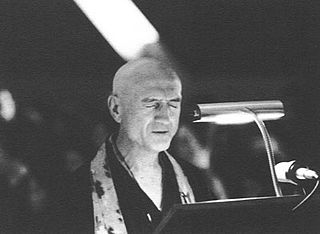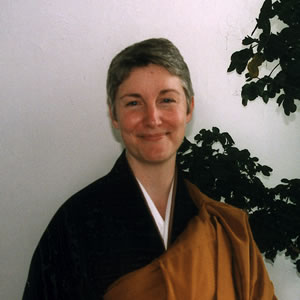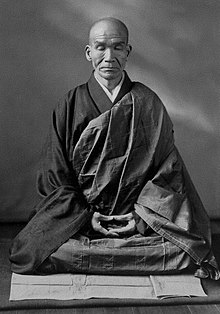A kōan is a story, dialogue, question, or statement from the Chinese Chan-lore, supplemented with commentaries, that is used in Zen practice to provoke the "great doubt" and initial insight of Zen-students. Prolonged koan-study shatters small-minded pride of, and identification with, this initial insight, and spurs further development of insight and compassion, and integration thereof in daily life and character.

Dōgen Zenji, also known as Dōgen Kigen (道元希玄), Eihei Dōgen (永平道元), Kōso Jōyō Daishi (高祖承陽大師), or Busshō Dentō Kokushi (仏性伝東国師), was a Japanese Buddhist priest, writer, poet, philosopher, and founder of the Sōtō school of Zen in Japan.

Sōtō Zen or the Sōtō school is the largest of the three traditional sects of Zen in Japanese Buddhism. It is the Japanese line of the Chinese Cáodòng school, which was founded during the Tang dynasty by Dòngshān Liánjiè. It emphasizes Shikantaza, meditation with no objects, anchors, or content. The meditator strives to be aware of the stream of thoughts, allowing them to arise and pass away without interference.
Shikantaza (只管打坐) is Dogen's Japanese translation of the Chinese phrase zhǐguǎn dǎzuò, "just sitting." The phrase was used by his teacher Rujing, a monk of the Caodong school of Chan Buddhism, to refer to the meditation-practice called "Silent Illumination", or "Serene Reflection," taught by the Caodong master Hongzhi Zhengjue (1091-1157). In Japan, it is associated with the Zen Soto school. In shikantaza one does not focus attention on a specific object ; instead, practitioners "just sit" in a state of conscious awareness.
Kenshō (見性) is a Japanese term from the Zen tradition. Ken means "seeing", shō means "nature, essence". It is usually translated as "seeing one's (true) nature", that is, the Buddha-nature or nature of mind.

Philip Kapleau was an American teacher of Zen Buddhism in the Sanbo Kyodan tradition, which is rooted in Japanese Sōtō and incorporates Rinzai-school koan-study. He also strongly advocated for Buddhist vegetarianism.

Hakuin Ekaku was one of the most influential figures in Japanese Zen Buddhism, who regarded bodhicitta, working for the benefit of others, as the ultimate concern of Zen-training. While never having received formal dharma transmission, he is regarded as the reviver of the Japanese Rinzai school from a period of stagnation, focusing on rigorous training methods integrating meditation and koan practice.

The Rinzai school is one of three sects of Zen in Japanese Buddhism, along with Sōtō and Ōbaku. The Chinese Linji school of Chan Buddhism was first transmitted to Japan by Myōan Eisai. Contemporary Japanese Rinzai is derived entirely from the Ōtōkan lineage transmitted through Hakuin Ekaku (1686–1769), who is a major figure in the revival of the Rinzai tradition.
The term makyō is a Japanese word that literally means "realm of demons/monsters" or "uncanny realm" or forsaken place, and hellhole.
Ōryōki, is a transliteration of Sanskrit pātra, also called 應量器, means "vessel that contains just enough" is a set of nested bowls and other eating utensils for the personal use of Buddhist monks. Ōryōki also refers to a meditative form of eating using these utensils that originated in Japan and emphasizes mindfulness awareness practice by abiding to a strict order of precise movements.

John Daido Loori was a Zen Buddhist rōshi who served as the abbot of Zen Mountain Monastery and was the founder of the Mountains and Rivers Order and CEO of Dharma Communications. Daido Loori received shiho from Taizan Maezumi in 1986 and also received a Dendo Kyoshi certificate formally from the Soto school of Japan in 1994. In 1997, he received dharma transmission in the Harada-Yasutani and Inzan lineages of Rinzai Zen as well. In 1996 he gave dharma transmission to his student Bonnie Myotai Treace, in 1997 to Geoffrey Shugen Arnold, and in 2009 to Konrad Ryushin Marchaj. In addition to his role as a Zen Buddhist priest, Loori was an exhibited photographer and author of more than twenty books and was an avid naturalist.

Hakuyū Taizan Maezumi was a Japanese Sōtō Zen Buddhist priest who substantially contributed to development of Zen in the USA.
Sanzen (参禅), aka nisshitsu (入室), means going to a Zen master for instruction. In the Rinzai school, it has the same meaning as dokusan, which is specifically a private interview between student and master, often centering on the student's grasp of an assigned koan. If the master rings a bell to dismiss the student, this means the student's understanding is not right and that their work with the koan must continue. It is typically held twice a day in a monastery, though during a week-long sesshin sanzen may take place as often as four times in one day.

Japanese Zen refers to the Japanese forms of Zen Buddhism, an originally Chinese Mahāyāna school of Buddhism that strongly emphasizes dhyāna, the meditative training of awareness and equanimity. This practice, according to Zen proponents, gives insight into one's true nature, or the emptiness of inherent existence, which opens the way to a liberated way of living.

Hakuun Yasutani was a Sōtō priest and the founder of the Sanbo Kyodan, a lay Japanese Zen group. Through his students Philip Kapleau and Taizan Maezumi, Yasutani has been one of the principal forces in founding western (lay) Zen-practice.

Kazuaki Tanahashi is an accomplished Japanese calligrapher, Zen teacher, author and translator of Buddhist texts from Japanese and Chinese to English, most notably works by Dogen. He first met Shunryu Suzuki in 1964, and upon reading Suzuki's book Zen Mind, Beginner's Mind he stated, "I could see it's Shobogenzo in a very plain, simple language." He has helped notable Zen teachers author books on Zen Buddhism, such as John Daido Loori. A fellow of the World Academy of Art and Science—Tanahashi is also an environmentalist and peaceworker.

Bonnie Myotai Treace is a Zen teacher and priest, the founder of Hermitage Heart, and formerly the abbot of the Zen Center of New York City (ZCNYC). She teaches currently in Black Mountain and Asheville, North Carolina. Myotai Sensei is the first Dharma successor of John Daido Loori, Roshi, in the Mountains and Rivers Order (MRO), having received shiho, dharma transmission, from him in 1996. Serving and training for over two decades in the MRO, she was the establishing teacher and first abbess of the ZCNYC. At the Monastery she was the Vice Abbot, the first director of Dharma Communications, editor of Mountain Record, and coordinator of the affiliates of the MRO. Treace, ordained as a Zen monastic, now lives as a lay teacher, working primarily with her long-term students.
Zen is a school of Mahayana Buddhism that originated in China during the Tang dynasty as the Chan School or the Buddha-mind school ," and later developed into various sub-schools and branches. From China, Chán spread south to Vietnam and became Vietnamese Thiền, northeast to Korea to become Seon Buddhism, and east to Japan, becoming Japanese Zen.
Zen was introduced in the United States at the end of the 19th century by Japanese teachers who went to America to serve groups of Japanese immigrants and become acquainted with the American culture. After World War II, interest from non-Asian Americans grew rapidly. This resulted in the commencement of an indigenous American Zen tradition which also influences the larger western (Zen) world.
Gaṇanā is the technique of breath counting in Buddhist meditation. It focuses on drawing mental attention to breathing by counting numerically inhalation and exhalation. It is part of the six stages of anapanasati described by auhors like Vasubandhu and Zhiyi, composed by counting breath (ganana), following the motions of the air flow (anugama), stilling thought in the body, observing the elements of air (upalakshana), transformation of the mind focused on the air (vivarthana) and entering the path of vision (parisuddhi). Those stages are increasingly subtle and lead to control of mind, producing samadhi in order to achieve vipassana.











